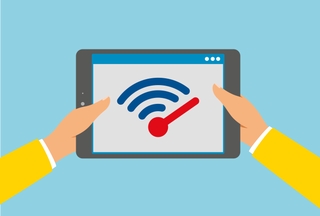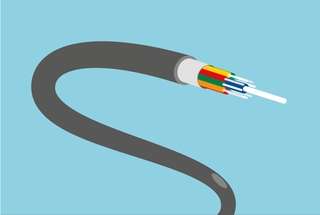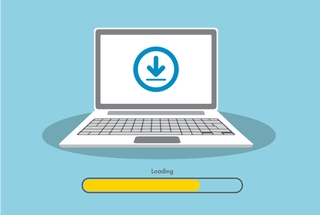Fibre optic broadband: what's the lowdown?
23 January 2020

Fibre broadband is becoming an increasingly popular way to connect to the internet. Here, we give you the lowdown on what it is and what the buzz is about. The super-fast internet speed sounds great, but what’s it for? What’s the difference between fibre broadband and standard broadband? You’ll find out the answers to these and more frequently asked questions, get to grips with relevant terminology and discover whether you need fibre broadband in your home.
What is fibre broadband?
Fibre broadband is short for fibre optic broadband, and it’s a type of technology that provides you with a super-fast internet connection. The speed comes from the use of plastic or glass “fibre optic” cables instead of traditional copper cables. Fibre optic cables allow for greater bandwidth, don’t lose signal strength over long distances, and are less prone to electromagnetic interference from other nearby cables.
The difference between broadband and fibre
The only difference between standard broadband and fibre optic broadband is the type of cables that are used between the telephone exchange and your home, so it’s really easy to switch if you want to.
Types of fibre broadband
The different types of fibre broadband are known by the way they’re connected to your home:
- The most common type of fibre broadband is known as FTTC, which stands for “Fibre to the Cabinet”. This type of fibre broadband uses fibre optic cables between the telephone exchange and the street cabinet, and then copper cables between the cabinet and your home.
- The other main types of fibre optic broadband are called FTTP, or “Fibre to the Premises” and FTTH, or “Fibre to the Home”. These are really fast kinds of internet connection because all the cables between the telephone exchange and your home are fibre optic.
- Ultra-fast fibre broadband like the new G.fast has been trialled using FTTdp, which is “Fibre to the Distribution Point”. Fibre optic cables are used between the telephone exchange and the distribution point (typically an adapted cabinet that has an extra pod on its side). Then the connection passes through copper cables between the distribution point and your home. G.fast can achieve ultra-fast speeds even through copper cables. Because of this, you’re likely to see a lot more FTTdp as ultra-fast fibre broadband becomes more widely available.

What is the difference between fibre broadband and cable broadband?
With most types of fibre broadband there are fibre optic cables between the telephone exchange and the street cabinet, and the section between the cabinet and your home is copper or fibre optic. Cable broadband also uses fibre optic cables between the telephone exchange and the street cabinet, but uses coaxial cables between the cabinet and your home. Coaxial cables have two concentric channels via which the signal travels, allowing for greater bandwidth and less interference than copper cables.
What is the difference between fibre broadband and standard ADSL broadband?
Fibre optic broadband uses fibre optic cables for most or all of the connection between the telephone exchange and your home. Standard broadband uses an ADSL connection that utilises the original copper telephone cables. The acronym stands for Asymmetric Digital Subscriber Line. An ADSL splitter or filter divides the signal into two frequencies so that voice and data can travel along the telephone line at the same time. This enables you to make and receive phone calls at the same time as using the internet.
The asymmetric aspect of ADSL means that the two directions of signal flow have different capacities. One direction has a greater capacity to allow for faster download speeds because you typically download more data than you upload.
How fast is fibre optic broadband?
Internet speed is measured in megabits per second, and this is often abbreviated to Mbps when talking about broadband packages. The fastest speed for most FTTC fibre optic broadband is 76Mbps, while ultra-fast broadband like G.fast and FTTP have speeds of up to 1Gbps (which is 1,000Mbps). In comparison, standard ADSL broadband has a maximum speed of 17Mbps and cable broadband currently around 500Mbps.

What factors in my home can affect internet speed?
- The internet is slower when more than one person is online using the same connection. Therefore if your home has multiple users you’ll need a high bandwidth service because it’s shared between all devices connected to the internet.
- Physical issues like wiring and hardware failure can affect internet speed. If there’s an unexplained drop in internet speed, it’s worth checking computers, cables and other components.
- The biggest factor that can affect internet speed in your home is Wi-Fi. The internet speed will always be slower when you connect with Wi-Fi. Gadgets like the microwave, cordless phones and baby monitors can also impact your Wi-Fi, further lowering the internet speed.
Can actual internet speed be different to the advertised speed?
When you browse any broadband deals, remember that the advertised download speeds are based on the average download speeds that customers will achieve.
When you sign up to any broadband service you will be given an estimated speed range that is specific to your line. However, it is important to remember that this is an estimate based on industry data and your actual internet speed could be slightly slower or slightly higher than the estimate provided.
What’s bandwidth?
Internet speed is sometimes referred to as bandwidth. Bandwidth largely correlates with internet speed, but it can be easier to think of it as the number of channels available through which signals can pass. Each channel is one-way, meaning that some channels only transmit data to your computer (downloading) and some only send signals from your computer (uploading). When browsing our broadband plans, you’ll find the bandwidth or internet speed given in Mbps.
What factors in my home can affect internet speed?
- Standard broadband can struggle to support homes with multiple users and multiple devices. Heavy-usage households and those with two or more active internet users will benefit from the higher bandwidths.
- Download times are much quicker than with standard ADSL broadband. For example, with a 17Mbps connection it takes about 7 minutes to download a film (of 858MB in size), with 38Mbps it takes 3 minutes and with 76Mbps it takes 1 minute 30 seconds.
- Fibre optic cables aren’t subject to electromagnetic interference from other cables so the connection’s more stable and reliable than other types of internet connection.
Do I need fibre optic broadband?

Fibre lets you do more. It’s well-equipped to handle everyone at home online at the same time, and it’s great for downloading or streaming movies, TV shows and music. You’ll be able to watch streaming services like Netflix and iPlayer with far less interruption.
How and where can I get fibre broadband?
It’s really easy to get fibre broadband. Simply check out our broadband plans and click on the one you want.
Pop in your postcode and we’ll rustle up your estimated maximum speed and call options. We’ll also let you know if an engineer will need to pop out to you. Review your order, enter your details and click to confirm – that’s all there is to it.